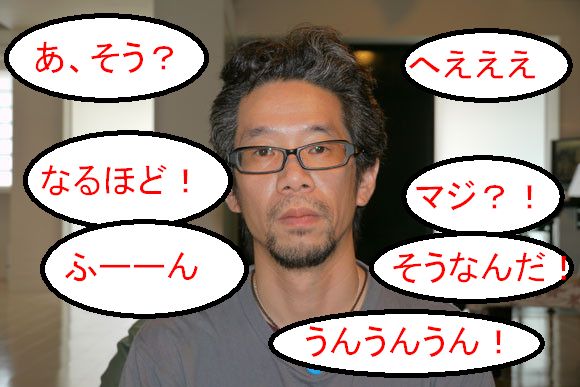
Chances are, if you’ve ever had a conversation in Japanese – or even any other language – with a native Japanese person, you might have been slightly disconcerted by their constant interjections.
That’s because nodding along, saying things like “I see” (naruhodo), “Oh really?” (sou desu ka?) and just plain grunting is considered a polite way to indicate to a speaker that you’re following along in a conversation.
This technique is called “aizuchi” in Japanese and, sure, it seems common sense in any culture to occasionally give a nod of the head or look up from your riveting game of Candy Crush Saga to indicate you have at least a passing interest in what’s being said, but the Japanese really turn it into an art form.
We’ll let YouTuber and Japan resident Micaela give you a sample of what it sounds and feels like below and then give our thoughts on this uniquely Japanese phenomena:
Micaela is generally absolutely right in that aizuchi can seem a little annoying to foreigners who aren’t used to it, but in reality, it isn’t, strictly speaking, always used to show a listener you’re following along. Like in other cultures, depending on tone and body language, aizuchi can also be used to indicate you want the speaker to get to the point or just wrap it up with the whole talking thing.
So, when a Japanese person says, “aa, sou?” , he/she could be indicating that they’re interested in what you’re saying, but it could also be a polite way of telling you, “Hey, I’m sure whatever you’re saying is very interesting, but right now I’m a little more interested in this delicious meatball sub, so could you come back later?”
“This is very important.”
Micaela’s point about conversations in Japanese tending to revolve around the listener’s obsession with your foreignness is also something that longtime foreign Japan residents can probably identify with. Just imagine if a foreigner’s idea of aizuchi was to interrupt dialogue with a Japanese speaker by shouting, “WOW! You can eat meatball subs? That is SOOO impressive!” (Sorry, I… have a lot of conversations about meatball subs.)
The indisputable deliciousness of meatball subs notwithstanding, if you’re learning Japanese, getting used to both hearing aizuchi and using them yourself is a great and pretty easy way to make your Japanese sound more natural and cut down on misunderstandings.
And, because we love you, here are a few suggestions (along with rough translations, but you’re better off learning how to use them by mimicking those around you) for great borderline-grunting sounds you can use to customize your aizuchi. Say them with an upward intonation to indicate intense interest, or in a flat monotone and with a blank, uninterested expression if you just want the speaker to shut up:
“eeeeeeeeh!” (“Whaaaat?”/”No way!”)
“Sou nan da!” (“Oh, that’s right!”/”Right, I get it!”)
“Naruhodo ne” (“Ah, so that’s how it is.”/”Right, I see.”)
“nnnnnnnn” (A deep and meaningful “I’m considering what you’re saying.”)
“fuuuuuuun” (“I’m listening, and it’s intriguing!”)
“Un un un!” (“Right, right right!”)
“KRAKAW! KRAKAW!” (Said while flapping your arms up and down like bird wings.)
We hope you find these useful, Japanese learners! And, be sure to upload your conversation to YouTube for us if you choose to use that last one.
Source: Kotaro Blog
Feature photo: RocketNews24
Inset: Croquille Master


 Learning Japanese? All you really need is this one word…
Learning Japanese? All you really need is this one word… Japanese Twitter shares the funniest “mysterious Japanese” that they’ve heard from foreigners
Japanese Twitter shares the funniest “mysterious Japanese” that they’ve heard from foreigners How to respond to Japanese people saying “I don’t speak English” when you’re speaking Japanese?
How to respond to Japanese people saying “I don’t speak English” when you’re speaking Japanese? Five magic Japanese phrases to know before starting a job in Japan
Five magic Japanese phrases to know before starting a job in Japan Four ways Japanese isn’t the hardest language to learn
Four ways Japanese isn’t the hardest language to learn Nagoya’s dark-red miso has continued to capture tastebuds for generations
Nagoya’s dark-red miso has continued to capture tastebuds for generations Happy New Year from SoraNews24!
Happy New Year from SoraNews24! We found possibly the quietest Japanese-style hotel in Tokyo’s bustling Shinjuku district
We found possibly the quietest Japanese-style hotel in Tokyo’s bustling Shinjuku district Japanese thug wear from Birth Japan perfect for those breaking bad next year
Japanese thug wear from Birth Japan perfect for those breaking bad next year This gachapon capsule machine dispenses real Akoya pearls, with certificates of authenticity
This gachapon capsule machine dispenses real Akoya pearls, with certificates of authenticity Godzilla-shaped ice cream on sale in Tokyo near the sight his most adorable rampage
Godzilla-shaped ice cream on sale in Tokyo near the sight his most adorable rampage Happy New Year from SoraNews24!
Happy New Year from SoraNews24! Six outdoor Japanese hot springs you can visit right now (with Google Street View)
Six outdoor Japanese hot springs you can visit right now (with Google Street View) The etiquette rules for visiting Shinto shrines in Japan
The etiquette rules for visiting Shinto shrines in Japan Japan Super Budget Dining – What’s the best way to spend 1,000 yen at beef bowl chain Sukiya?
Japan Super Budget Dining – What’s the best way to spend 1,000 yen at beef bowl chain Sukiya? Starbucks Japan ready to get Year of the Horse started with adorable drinkware and plushies【Pics】
Starbucks Japan ready to get Year of the Horse started with adorable drinkware and plushies【Pics】 Lacquerware supplier to emperor of Japan and Pokémon team up for new tableware
Lacquerware supplier to emperor of Japan and Pokémon team up for new tableware Japan may add Japanese language proficiency, lifestyle classes to permanent foreign resident requirements
Japan may add Japanese language proficiency, lifestyle classes to permanent foreign resident requirements 7-Eleven Japan’s ramen-cooking robot whipped us up a bowl of noodles【Taste test】
7-Eleven Japan’s ramen-cooking robot whipped us up a bowl of noodles【Taste test】 Cyberpunk anime meets traditional culture in Ghost in the Shell gold leaf Japanese changing screens
Cyberpunk anime meets traditional culture in Ghost in the Shell gold leaf Japanese changing screens Disillusionment at Tsukiji’s tourist-target prices led us to a great ramen restaurant in Tokyo
Disillusionment at Tsukiji’s tourist-target prices led us to a great ramen restaurant in Tokyo 7 great places to see Mt. Fuji from without having to climb it
7 great places to see Mt. Fuji from without having to climb it Hello Kitty Choco Egg figures are an adorable trip through three periods of Japanese pop culture【Pics】
Hello Kitty Choco Egg figures are an adorable trip through three periods of Japanese pop culture【Pics】 Starbucks Japan releases new zodiac chilled cup drink for 2026
Starbucks Japan releases new zodiac chilled cup drink for 2026 Japan’s otoshidama tradition of giving kids money at New Year’s gets a social welfare upgrade
Japan’s otoshidama tradition of giving kids money at New Year’s gets a social welfare upgrade 7-Eleven Japan starts new temporary luggage storage service in over 300 branches
7-Eleven Japan starts new temporary luggage storage service in over 300 branches Starbucks teams up with 166-year-old Kyoto doll maker for Year of the Horse decorations【Photos】
Starbucks teams up with 166-year-old Kyoto doll maker for Year of the Horse decorations【Photos】 Tokyo considering law requiring more trash cans following litter increase in heavily touristed area
Tokyo considering law requiring more trash cans following litter increase in heavily touristed area Tokyo’s Tsukiji sushi neighborhood asks tour groups to stay away for the rest of the month
Tokyo’s Tsukiji sushi neighborhood asks tour groups to stay away for the rest of the month Nintendo’s Kirby now delivering orders at Kura Sushi restaurants, but not in Japan
Nintendo’s Kirby now delivering orders at Kura Sushi restaurants, but not in Japan Tokyo event lets you travel back in time, for free, to celebrate 100 years since Showa era start
Tokyo event lets you travel back in time, for free, to celebrate 100 years since Showa era start Sanrio theme park in Japan announces plans to expand into a Sanrio resort
Sanrio theme park in Japan announces plans to expand into a Sanrio resort Stamina-destroying “Paralysis Noodles” are Tokyo’s newest over-the-top ramen innovation
Stamina-destroying “Paralysis Noodles” are Tokyo’s newest over-the-top ramen innovation Survey asks foreign tourists what bothered them in Japan, more than half gave same answer
Survey asks foreign tourists what bothered them in Japan, more than half gave same answer Japan’s human washing machines will go on sale to general public, demos to be held in Tokyo
Japan’s human washing machines will go on sale to general public, demos to be held in Tokyo Japan’s deadliest food claims more victims, but why do people keep eating it for New Year’s?
Japan’s deadliest food claims more victims, but why do people keep eating it for New Year’s? We deeply regret going into this tunnel on our walk in the mountains of Japan
We deeply regret going into this tunnel on our walk in the mountains of Japan Studio Ghibli releases Kodama forest spirits from Princess Mononoke to light up your home
Studio Ghibli releases Kodama forest spirits from Princess Mononoke to light up your home Major Japanese hotel chain says reservations via overseas booking sites may not be valid
Major Japanese hotel chain says reservations via overseas booking sites may not be valid Put sesame oil in your coffee? Japanese maker says it’s the best way to start your day【Taste test】
Put sesame oil in your coffee? Japanese maker says it’s the best way to start your day【Taste test】 No more using real katana for tourism activities, Japan’s National Police Agency says
No more using real katana for tourism activities, Japan’s National Police Agency says Starbucks Japan reveals new sakura drinkware collection, inspired by evening cherry blossoms
Starbucks Japan reveals new sakura drinkware collection, inspired by evening cherry blossoms Updated cherry blossom forecast shows extra-long sakura season for Japan this year
Updated cherry blossom forecast shows extra-long sakura season for Japan this year English conversation school in Japan has clever reminder that students don’t have to be perfect
English conversation school in Japan has clever reminder that students don’t have to be perfect Japanese Internet sad to see the word “chikan” becoming commonly used in English
Japanese Internet sad to see the word “chikan” becoming commonly used in English Learn Japanese from YouTube: Amp up your listening skills with this four-step guide
Learn Japanese from YouTube: Amp up your listening skills with this four-step guide Hachiji juppun mae – A Japanese phrase that even Japanese people can’t agree on the meaning of
Hachiji juppun mae – A Japanese phrase that even Japanese people can’t agree on the meaning of 10 things foreigners do that Japanese people find amusing
10 things foreigners do that Japanese people find amusing What does “Konnichiwa” really mean? Understanding Japanese greetings
What does “Konnichiwa” really mean? Understanding Japanese greetings Laugh and learn! Japanese language school for foreigners teaches real Japanese with manzai comedy
Laugh and learn! Japanese language school for foreigners teaches real Japanese with manzai comedy Tea cups and biting breasts: Japanese phrases that sound like weird English
Tea cups and biting breasts: Japanese phrases that sound like weird English Six (and a half) essential resources for learning Japanese
Six (and a half) essential resources for learning Japanese Language fail: 22 funny and embarrassing tales of Japanese language missteps
Language fail: 22 funny and embarrassing tales of Japanese language missteps Talk with your hands — Mr Sato tests your knowledge of common Japanese hand gestures【Video】
Talk with your hands — Mr Sato tests your knowledge of common Japanese hand gestures【Video】
Leave a Reply